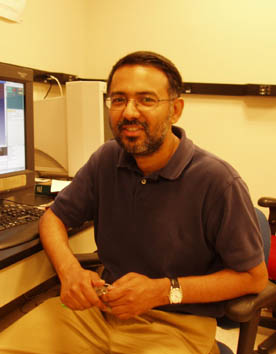Our Science – Subramaniam Website
Sriram Subramaniam, Ph.D.
 |
|
|||||||||||||||||||||||
Biography
Dr. Sriram Subramaniam obtained his Ph.D. in physical chemistry from Stanford University in 1987 and carried out postdoctoral work in the departments of chemistry and biology at the Massachusetts Institute of Technology. In 1992, he joined the faculty at the Johns Hopkins University School of Medicine as an assistant professor, and was promoted to associate professor in 1998. He was appointed as Chief of the Biophysics Section in the Laboratory of Biochemistry in 1998, and subsequently Chief of the Biophysics Section in the Laboratory of Cell Biology in 2003. He continues to maintain a visiting faculty appointment with the Johns Hopkins University School of Medicine.
Research
Three-Dimensional Electron Microscopy at Molecular Resolution
For a more detailed description of our research program, please visit our lab's Web site at http://electron.nci.nih.gov.
The long-term mission of our research program is to obtain an integrated, quantitative understanding of cells and viruses at molecular resolution. We take an interdisciplinary approach to this problem by combining novel technologies for three-dimensional (3D) imaging with computational and cell biological tools. Our research efforts are presently focused on three areas: (1) determination of the structure and mechanisms underlying neutralization and cellular entry of HIV, (2) determination of the dynamic architecture of the bacterial chemotaxis apparatus and quantitative understanding of steps in signal transduction, and (3) the development of novel technologies for 3D imaging of cells and tissues, with particular emphasis on methods for understanding and diagnosing structural signatures of cancer cells.
This page was last updated on 9/28/2008.

